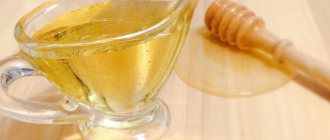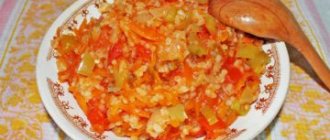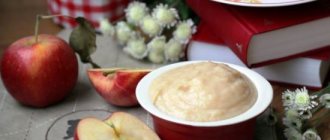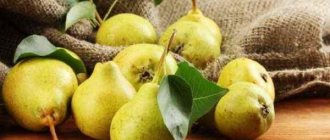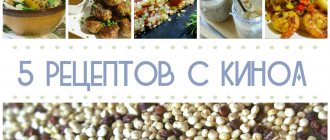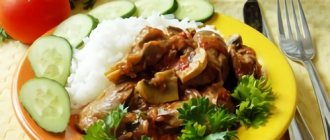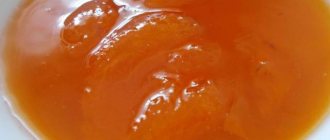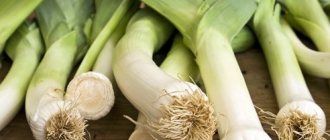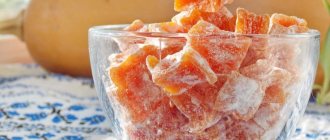There are times when bees do not have enough honey to feed themselves, so knowing how to properly prepare and distribute sugar syrup should be a basic skill for every beekeeper.
ShareTweetVkOdnoklassniki
If there is a lack of honey and bee bread in the nest, it is impossible to do without substitutes, especially when replenishing food reserves for the winter, or stimulating the queen’s egg-laying while increasing the colony’s strength for honey collection. A substitute for honey in this case is beet or cane sugar. The consistency of such food is liquid - sugar syrups; dough-like - sugar or sugar-honey dough; hard ones - caramel. All prepared feed must meet the standards, because... only in this case will their use be relatively safe for the life of bee colonies.
Ingredients of sugar syrup for bees
The first thing that is important to pay attention to is that sugar syrup is prepared only from good-quality table sugar. Raw sugar, which has a dark or brownish color and the smell of molasses, is absolutely unsuitable for making syrup. Sugar waste can be used only if it does not contain impurities harmful to bees - these are various acids, fertilizers, etc. You should also not use candies that have lost their presentation or are expired.
The second important addition is that when preparing sugar syrup, burning of sugar is unacceptable, because caramelization occurs, resulting in the formation of substances harmful to bees. And it should also be remembered that keeping the syrup for more than 5 hours at temperatures above 45 degrees is also undesirable, because this leads to a deterioration in its quality.
The water should be soft drinking. Hard water is unsuitable. You can use boiled, uncontaminated snow or rain water. Considering that such water and sugar do not contain the minerals that are contained in the natural food of bees - honey, it is important to introduce at least the main components of these minerals into the syrup being prepared. That is, for every liter of water used to prepare the syrup, you can add 0.5 grams of sea salt (or half a teaspoon per 10 liters of water) .
Juices, compotes, syrups. The best recipes for drinks from your harvestGalina Kizima, 2020
Syrups are prepared from natural fruit and berry juices, boiled with sugar, with the addition of citric acid and aromatic substances. The most delicious syrups are made from strawberries, raspberries, cherries, dogwoods, etc.
If the syrup is drunk through a straw or straw, then it must be diluted with carbonated or plain water, acidified with lemon juice or citric acid. Syrups can also be used to fill various sweet products - buns, crumpets, creams, jelly, milk porridges, especially rice porridge, soufflé, etc. - this enriches, flavors and improves their taste.
Syrups and extracts can be prepared either hot (by boiling) or cold. For example, to prepare syrups by boiling, you need to select healthy, beautiful, ripe fruits, rinse thoroughly in cold water, and then extract the juice from them. Depending on the fruit, various methods for obtaining juice can be used. Let the juice settle, strain through cheesecloth until it becomes completely transparent, put on low heat, heat, but do not boil yet, and add sugar (for 700 ml of juice - 1.5 kg of sugar). Cook over low heat, stirring constantly, until the sugar is completely dissolved. After the sugar has dissolved, bring the syrup to a boil and simmer for 3-5 minutes.
The foam that begins to form at the beginning of cooking is not removed. You just need to constantly break it up with a slotted spoon. At the end of cooking, especially if the opaque juice is boiled down, thick foam appears; it must be skimmed off.
After boiling for 3-5 minutes, add tartaric or citric acid to the syrup (5-10 g of acid per kilogram of sugar) and cook for a few more minutes. Then turn off and remove from heat. Strain the hot syrup through cheesecloth, cool and pour into dry jars.
There is another cold way
preparing syrup. In this way, syrups are mainly prepared from raspberries, strawberries, black currants, blueberries, and lingonberries.
The syrup prepared in a cold way is not candied; it retains the color and aroma of the fruits and berries from which it is made.
The juice is squeezed from healthy, ripe fruits, filtered, tartaric or citric acid, sugar are added and everything is thoroughly mixed until the sugar and acid are completely dissolved. The recommended ratio of juice, sugar and acid is as follows: juice - 350 ml, sugar - 650 g, acid (tartaric or citric) - 5-10 g (depending on which fruit the juice is squeezed from). The syrup is then filtered and poured into dry bottles.
Fill the bottles to the base of the neck, seal with stoppers and fill with paraffin, dipping the neck in molten paraffin, or seal with sealing wax.
Store in a cool dry place.
Proportions of sugar feeding for bees
Sugar syrup is prepared at 50, 60, and 66 percent concentrations by dissolving 5, 6, and 6.6 kilograms of sugar, respectively, in 5, 4, and 3.4 liters of water. But most often in apiaries, syrup is used in a concentration of 50 (1:1) or 66 percent (3:2). In these proportions, sugar is completely soluble in water, and therefore there is no need to boil the solution.
In beekeeping practice, it is customary to use thick (3:2) solutions early in the spring, even before flight, and in the fall to replenish missing winter reserves. More liquid (1:1) syrups are used for spring and summer feeding. This is explained by the fact that its water content is more similar to the nectar of plant flowers, and when processed in the warm season, it is easier for bees to evaporate excess liquid from it.
The missing reserves are replenished on the basis that one kilogram of sugar gives one kilogram of sealed feed. But syrup is given not in kilograms, but in liters, and the capacity of the feeders is also measured in them. To calculate the required amount of syrup, you should know that one kilogram of sugar and one liter of water (1:1) produces 1.6 liters of syrup. And from three kilograms of sugar and two liters of water (3:2) the volume is 3.8 liters. Based on this, it is easy to calculate how many liters of syrup should be given to each family.
You can also conveniently use the corresponding tables. They contain all the necessary information, dosages, time of use and output volume. These are rounded figures for water and sugar. To prepare a different amount of food, you need to proportionally increase or decrease the weight and volume of ingredients.
To prepare 50% feed, this table will help:
| Syrup quantity | Proportions | Calculation of ingredients | Usage time |
| 1 l | 0.6 kg granulated sugar per 0.6 liters of liquid | ||
| 5 l | 1 to 1 (50%) | 3.1 kg granulated sugar per 3.1 liters of liquid | In the spring after the flyby |
| 10 l | 6.2 kg granulated sugar per 6.2 liters of liquid |
If you need to make the fertilizer thicker, you can use the table for preparing a 60% solution:
| Syrup quantity | Proportions | Calculation of ingredients | Usage time |
| 1 l | 0.8 kg granulated sugar per 0.6 liter of liquid | ||
| 5 l | 1.5 to 1 (60%) | 4 kg granulated sugar per 2.7 liters of liquid | In spring before flight and in autumn as winter feeding |
| 10 l | 8 kg granulated sugar per 5.4 liters of liquid |
Why and when do you need to feed with sugar syrup?
Every beekeeper knows that there are periods when bees do not have enough food reserves and therefore they need to be additionally fed with honey or sugar syrup. And if feeding with honey is considered highly effective and contains all the necessary substances, but is quite expensive, then sugar syrup is a convenient and inexpensive product, as well as easy to prepare, but you should not feed the bees only syrup for too long, since with such a diet it is much more difficult for them to grow offspring.
Feeding bees with sugar syrup in bags
Feeding with sugar syrup is required in the following cases:
- To increase food supplies for bees for the winter, as well as, if necessary, to replace low-quality honey for a favorable wintering of bees.
- In the spring, when there is insufficient food in the hives until natural food appears - pollen and nectar.
- To stimulate the cultivation of young offspring in the absence of flowering plants.
- For the prevention of foulbrood diseases in apiaries, if there were sick families there in the past.
Replenishment of food is necessary in cases where the bees were unable to stock up on the required amount of provisions or the cold lasted for a long time, and food was no longer running out.
How to make sugar syrup for bees
Preparing syrup for feeding is a simple matter, but it requires attentiveness and accuracy from the beekeeper. The quality of the finished product, as well as the health of the insects that consume it, depend on this.
Actually, the cooking process:
- You need a suitable container - a bucket or pan, preferably enameled. Their size is selected based on the final volume of the product.
- Clean water in a volume that corresponds to the selected recipe is poured into this vessel.
- It is placed on the fire and brought to a boil.
- The container is removed from the heat, sugar is poured into it and thoroughly stirred until it is completely dissolved.
- The prepared syrup is cooled to a temperature of 30 - 35 degrees, after which it is poured into feeders.
If necessary, herbal decoctions and various medications can be added to the already cooled syrup. For better processing of syrup by bees, some beekeepers add honey in amounts up to 10%. It is believed that this composition is more beneficial for them.
Classic recipe for sugar syrup for kutia
Ingredients
- White granulated sugar - 4 tbsp. l. + —
- Purified water - 6 tbsp. l. + —
Add all
to shopping list
Remove everything
from shopping list Shopping list
How to properly prepare syrup for kutia from sugar with your own hands
- Pour some water into a small saucepan and let it heat over medium heat.
- When the water starts to boil, carefully add sugar little by little and stir constantly.
- As soon as the solution begins to boil confidently, reduce the heat to minimum and continue stirring.
- Cook our syrup for 1-2 minutes, then remove from heat and let cool slightly. During this time, you will need to stir it several times so that it thickens evenly.
We pour the finished syrup directly into the kutya or first mix it with nuts and dried fruits, and only then add it to the porridge.
The thickness of this sauce can be adjusted by changing the proportions of sugar and water. So, if you take sand and water in the same volume, the syrup will be more viscous. Just increasing the amount of sugar will make the syrup more like fudge.
Sugar syrup. Recipe and methods of use
Sugar syrup is used very often in the preparation of various confectionery products from dough, as well as for fruit preparations. This is a truly universal base for all types of compotes, jams, candied fruits and much more. Moreover, both the taste of fruit preparations and the duration of their storage depend on how well and correctly the syrup is brewed.
How to prepare sugar syrup? The recipe is very simple. Pour water into the pan, add granulated sugar, mix everything well, place it on the stove so that only one side is very hot, then foam will accumulate on the other, which must be periodically removed with a spoon. When the formation of foam stops, the pan is completely shifted to high heat and the mixture is boiled until the syrup of the required thickness is obtained.
Depending on the purpose for which the sugar syrup is intended, the recipe is selected with a certain ratio of sugar and water. So, for impregnation of confectionery products, cakes, rum baba, pastries, etc. this ratio in syrup should be 1x1, i.e. 50% sugar and 50% water. There is no need to cook the syrup for a long time for impregnation; just heat the water with sugar until it is completely dissolved. Various aromatic substances, as well as rum and liqueurs, are added to impregnation syrups to give them a certain taste and aroma.
How to make sugar syrup for sweet preparations? To prepare fruit compotes, the syrup is boiled for a long time until the ratio of water and sugar in it is 3x1, i.e. 25% water and 75% sugar. There is a way to check the readiness of such syrup. If you hold a hot drop of syrup between your fingertips and then move them apart, a thin sweet string of syrup should form between your fingers. Fruits or berries (and sometimes both together) are placed in jars and sugar syrup is poured on top. The recipe for homemade fruit compote prepared in this way is very common. Sugar syrup of the same density and density is used as a basis for making jam from hard, dense fruits.
How to prepare candied fruits? They are immersed in a thick, dense sugar syrup, the recipe for which provides for a water to sugar ratio of 1x6, i.e. 85% sugar and 15% water. The fruits are kept in hot syrup until it cools completely, then carefully laid out on a flat surface and dried.
Even thicker syrup is used to prepare sugar fondant, which is used to glaze confectionery products. For such fudge, the finished sugar syrup should be in the proportion of water and sugar, like 1x9. It is boiled to the required density and thickness (to check, roll a soft ball from the drop). Then, after cooling, it is whipped until a matte white plastic mass is obtained, to which various aromatic additives are added for taste. It can be flavored with liqueurs, fruit juices, liqueurs, etc.
For glazing gingerbreads, cookies, yeast confectionery and fruits, the so-called circulation is used - this is boiled flavored sugar syrup. The recipe for preparing the circulation is as follows. Well-boiled sugar syrup (to a ratio of one to ten) is cooled slightly, the zest of lemon, orange or tangerine is added and applied hot with a brush to the surface of the products, or the gingerbread is placed in a pan and the hot batch is poured on top. Shake the pan thoroughly until all the products are covered with sugar syrup.
Sugar and water are the two most important and only ingredients in the production of a much-needed and universal product, without which one cannot do in the preparation of compotes and jam, as well as many confectionery products. The thickness and density of the syrup depends on the ratio of water and sugar in it, which can be determined in various ways (checking for a thin and thick thread, a soft and hard ball).
Cooking[ | ]
Sugar syrup is prepared for short-term and long-term storage; depending on this, the methods of its preparation may differ. It can be used for dessert dishes and cocktails.
First method[ | ]
To prepare a portion of sugar syrup, take 250 milliliters of water and 350 grams of granulated sugar. Water is poured into a container, then granulated sugar is poured into it and cooked over low heat for 10 minutes. The ingredients are constantly mixed and the foam is skimmed off. Once prepared, sugar syrup is used as an additive for cocktails or other dishes[3].
Second method[ | ]
Take 600 grams of sugar and 400 milliliters of water, mix, put on fire, bring to a boil for 8-10 minutes. The resulting foam is removed with a spoon [4].
Canning[ | ]
Syrup for canning is prepared in a large basin, the same as that intended for jam. Pour water, add sugar. When the syrup boils, remove the foam with a slotted spoon. The prepared syrup is filtered through cheesecloth[2].
